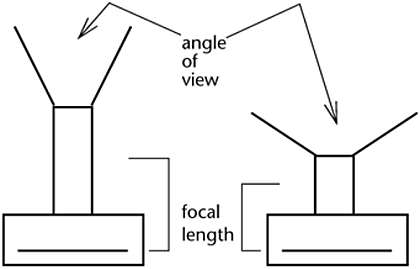For every shot, you can decide how big an object appears in the frame, for example, whether a shot includes an entire character or just its head and shoulders. This is directly controlled by adjusting the field of view.
The field of view is the amount of a scene (measurable in terms of area) that can be viewed by the camera. The field of view can be altered by changing the angle of view or the distance between the camera and the subject. See Moving the 3D Camera.
About the Angle of View
The angle of view, or more accurately, the angular field of view, is the amount of a scene (measurable in terms of an angle in degrees, originating at the camera position) that can be viewed by the camera. The angle of view is not affected by changes in the distance between camera and subject. It can be modified directly, in the FOV field, or indirectly, via the Focal Length field.
The angle of view and the focal length are inversely proportional. As you extend the camera's focal length, the field of view gets narrower. As you shorten the focal length, the field of view gets larger.

Playing with the relationship between distance and angle of view affects the focus and perspective of objects in the scene that can be used to creative advantage.
For example, a pair of objects that are placed a distance apart from each other, but in line with the camera, can appear differently when changing these two parameters.
If these objects are viewed by a camera at long range, but using a lens with a high focal length (narrow angle of view), they will appear large in the frame and in equal focus, and will seem to be located on the same plane.
These same objects, when viewed at close range, but using a lens with a low focal length (wide angle of view), will appear to also fill the frame, but the size difference between them will be exaggerated (the foreground object will appear much bigger than the background object) and there will be a very noticeable focus difference.
Focal Length
The focal length of a lens is the distance from the center of the lens to the film plane. The shorter the focal length, the closer the focal plane is to the back of the lens. Focal length is usually expressed in millimeters.
The object's size in the frame is directly proportional to the focal length. If you double the focal length (keeping the distance from the camera to the object constant), the subject appears twice as large in the frame. The size of the object in the frame is inversely proportional to the object's distance from the camera. If you double the distance, you reduce the size of the object by half in the frame.